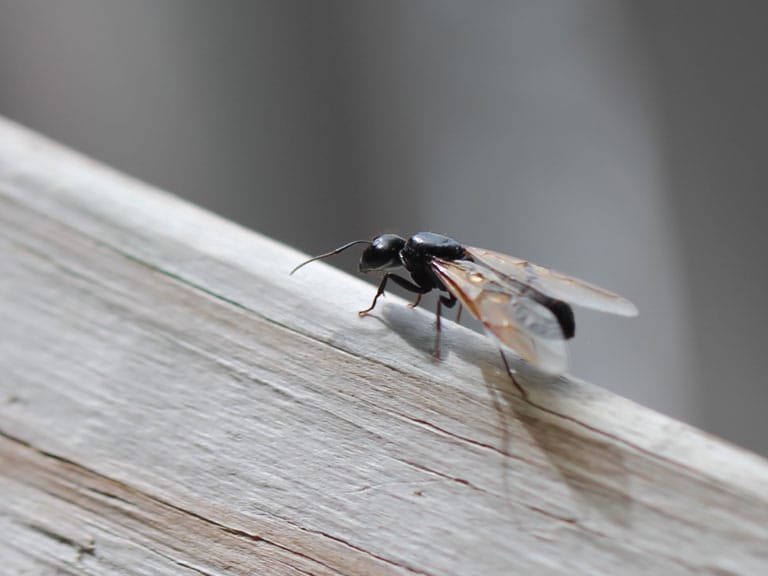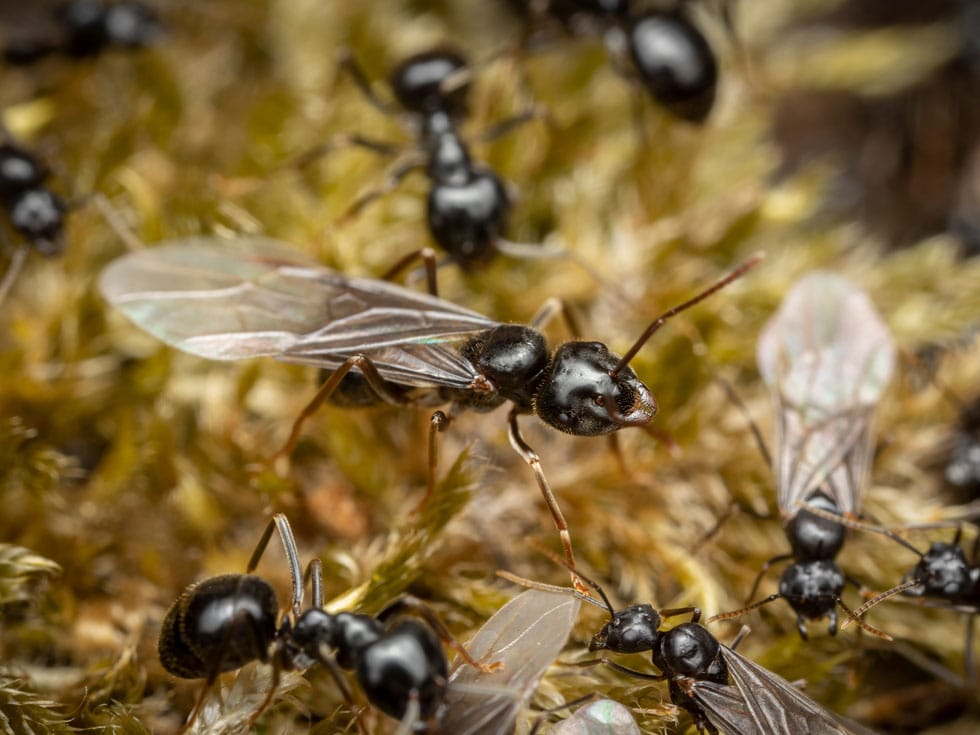In Quebec, it’s not uncommon to see large numbers of flying ants appearing in the summer, especially in August. This impressive phenomenon can raise many questions. What are they doing there? Should we be concerned?
In this article, we explain what they are, why they appear, and how to get rid of them.
Need help identifying an insect in your home or on your property? Talk with an ant exterminator.
What is a flying ant?
What we call a “flying ant” is actually a fertile ant ready for the mating season. These ants develop wings and leave their colony to participate in a nuptial flight (or mating flight), during which they mate.
The fertilized females then lose their wings and look for a place to start a new colony. If they succeed, they become new queens. The males, on the other hand, die shortly after mating.
The other ants, called workers, are sterile and wingless.
How to recognize a flying ant
The appearance of flying ants can vary depending on the species: some are larger, darker, or more reddish.
But they share common characteristics: a well-defined, slender waist, elbowed antennae, and two pairs of wings (the front ones are longer than the back ones).
Winged ant or termite?
Since both winged termites and flying ants can appear during the warmer months, it’s easy to confuse them. There are several ways to tell them apart. The termite has a straight body, straight antennae, and four wings of equal length.

Flying ants and swarming periods: the mating flight of ants
Every summer, sometimes after heavy rains followed by heat, we can see flying ants appear, sometimes in very large numbers. In Quebec, this phenomenon frequently occurs in July or August. The thousands of winged ants in flight or gathered on the ground sometimes even make headlines. This is called the swarming period.
Although impressive, the mating flight is rather brief and signals the start of a new colony.
Why do they appear around or inside the house?
When swarming, flying ants seek out open, bright, and sometimes humid places to fly or land. This is why they can be seen:
- On window sills;
- Near light fixtures;
- In the garden, on the patio, or near the foundations;
- And sometimes inside homes.
But be careful. If you find several flying ants inside (especially if it’s not their season), this could be a sign that a mature carpenter ants’ nest is inside the house. It’s best to have it inspected quickly by contacting professionals who are experts in the extermination of carpenter ants.
Where do ants build their nest?
After mating, fertilized females lose their wings and search out a quiet, sheltered place to establish a colony. Depending on the species, this may be:
- in the ground (lawn, cracks in the sidewalk);
- under stones, in stumps or rotting wood;
- in walls, wooden structures, or insulation (in the case of carpenter ants, which can cause damage to buildings).
Do flying ants sting?
Generally, flying ants are not aggressive. Some species may pinch if threatened, but they do not sting like wasps or bees. Their presence is disturbing mainly because of their large numbers.
What solutions are available against flying ants?
When outdoors, flying ants are simply engaging in their natural reproductive cycle. This process is generally short-lived and does not require any special intervention.
However, you should remain vigilant. Why? Because once swarming is complete, the fertilized queens seek out a quiet spot where they can start to grow their colony. And the spot they find may very well be near a house.
To repel flying ants naturally, you can use repellents in areas where they like to pass. Here are some natural solutions:
- White vinegar;
- Essential oils (peppermint or lavender);
- Diatomaceous earth.
Flying ants indoors: What can you do?
If you notice flying ants inside your home, this may indicate the presence of an established colony nearby or even inside your home. Here are some steps to take:
- Monitor their activity and try to determine where they are coming from and if there are many of them.
- Eliminate things that can attract them by cleaning surfaces and storing food in closed containers.
- Block entry points by sealing any cracks or openings through which they could come in.
If the invasion persists, it is strongly recommended to call on the services of a professional exterminator to assess the situation and offer customized solutions.
When should you call a pest control professional?
A few flying ants outdoors are not generally a cause for serious concern. However, if they return indoors in large numbers or if you see them outside of normal periods (such as in winter or early spring), there may be an active nest in your home.
Some species, such as carpenter ants, can cause significant damage to wood and remain very discreet for long periods of time.
In these cases, professional intervention is necessary to find the nest and successfully exterminate it.

